Yoga is amazing for opening tight hips, but can also be problematic if you have joint problems. Here are some tips for safely doing yoga with FAI hip impingement
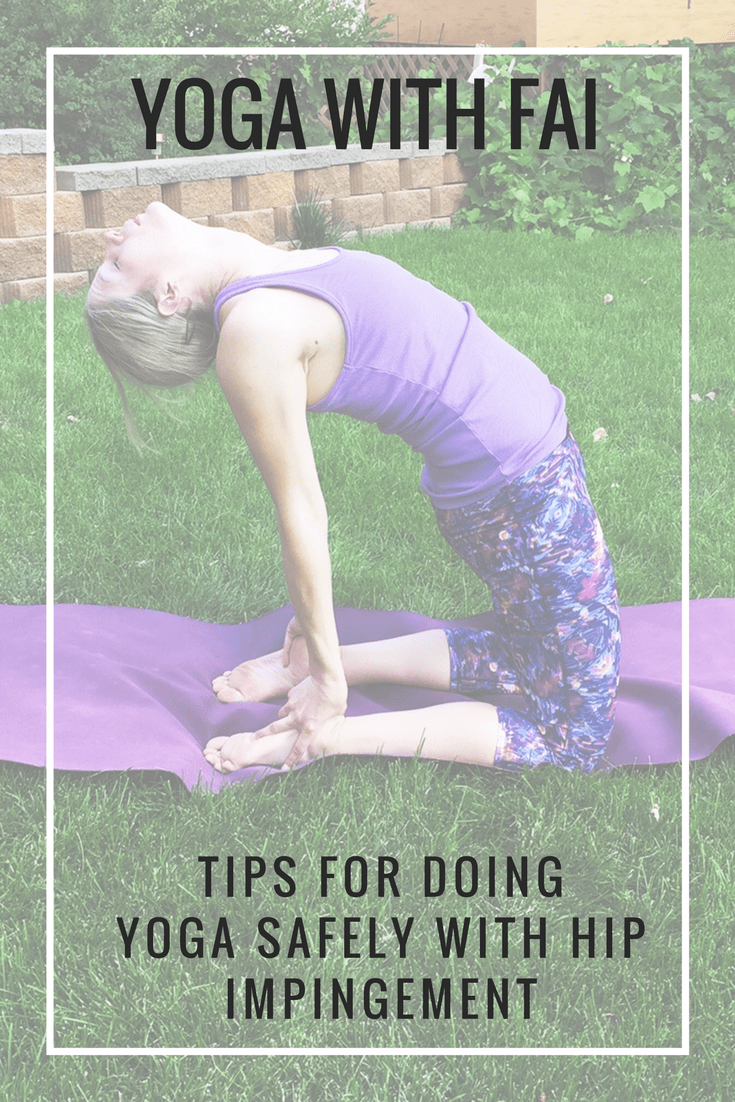
Hey, friends! It’s been a while since I posted about my FAI hip impingement, but I have been wanting to do a follow-up post for several months now. I’ve had quite a few blog comments and messages on social media asking about doing yoga with FAI hip impingement, so I decided it was time to write some more about how I modify my yoga to work with my hips.
Read my other blog post about staying fit with FAI
Eventually I would like to do a video to accompany this post, but I wanted to put this out there sooner rather than later, so no video with this one (yet!). When I do add video, it will be how I modify yoga poses for my hips. I’ll also work on adding more of my own photos to this post as well (with modifications) so you don’t have to go to so many other websites to see them 😉

FAI hip impingement and yoga
If you have hip problems or FAI (femoro acetabular impingement), yoga can be tricky. On one hand, it is great for helping with mobility in the hips and other joints, but on the other hand, it can cause a ton of stress on the hip joint and increase pain if you have FAI and you’re not being careful with your yoga poses.
If you have FAI and choose not to have hip reconstruction surgery, you will have accept that not all yoga poses are going to be okay for you, and there are many that you should not be doing at all.
Once I accepted my physical limitations, I was able to enjoy yoga more within my ability level without stressing about the poses I couldn’t do. Choose to focus on what you can do and not on what you can’t do!
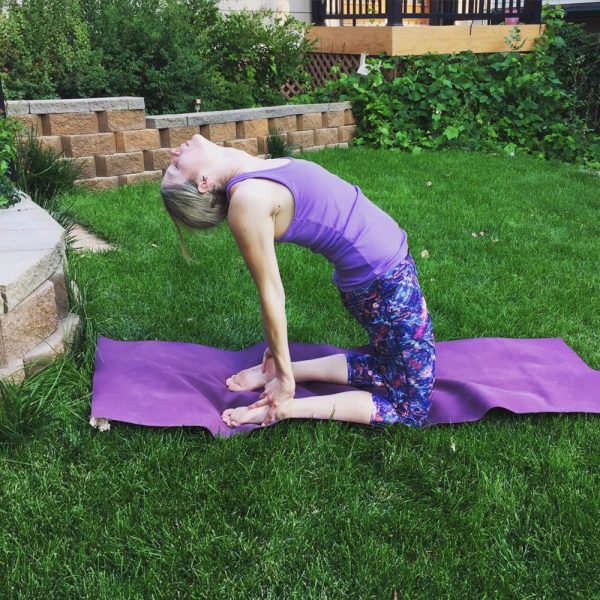
Modification and listening to your body in yoga is KEY if you have joint problems.
If a pose doesn’t feel comfortable, modify it or don’t do it at all. I can’t do happy baby pose the way my hips are. It’s physically impossible for me to do unless I decide to tear up my hip cartilage trying. BUT that’s okay, I don’t even try to do that pose anymore, and my hips are happier for it!
I modify my low lunges with a block to keep my hips happy. I can do low lunge without the block, but I choose to use it to make sure that my hips don’t start hurting again.
Tip: Don’t sink into your hip joints (or any joints) in yoga poses.
For example, in Warrior 3 (Virabhadrasana III), use the muscles in your legs and hips to keep your body from sinking or relaxing into the hip joint. It’s easy to let yourself just relax into those poses and “settle in” to your joints, but resist the urge and engage your muscles to protect your joints.
Another example of this with the shoulder joints is side plank pose: it is easy to sink into the shoulder joint, but to protect your shoulders, imagine that you are lifting up away from the floor so you aren’t sinking into that supporting joint. Engaged muscles = happy joints!
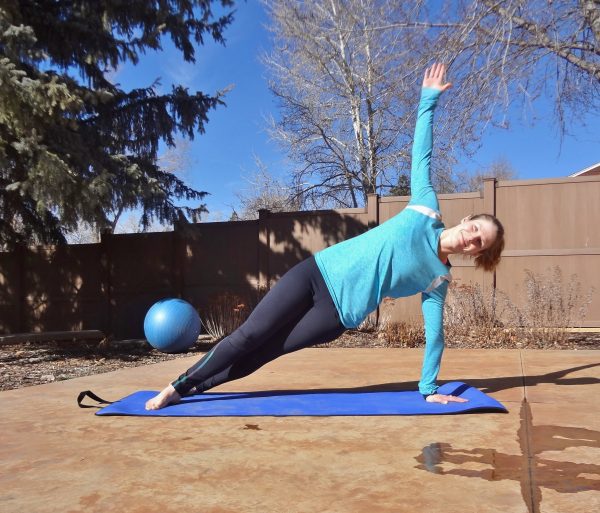
Make sure that you are practicing yoga with intention, attention, and focus!
Yoga poses to avoid or modify with FAI
Here’s a list of yoga poses that could potentially cause problems for people with FAI. Whether a pose bothers you or not is going to be highly individual, so this list may be different for everyone, but these are the poses that I have had to use caution with when my hips were bothering me (and I still have to avoid a few, like happy baby).
I also have a bone spur in my left hip, making some poses on my left side a little bit more difficult sometimes than on my right (particularly cow face pose and half lord of the fishes pose). If you have impingement only on one side or bone spurs on one side, keep that in mind when you’re doing your poses.
Generally, any yoga pose that puts your hip joints at a small angle could cause problems for your hips if you have FAI. If my knees are out to the side, I don’t have as many problems (like in seated butterfly).
Poses you may want to avoid:
- Happy baby pose
- Marichyasana I (Marichi’s Pose)
- Garland pose
- Deep side lunge
- Standing splits
- Lizard pose
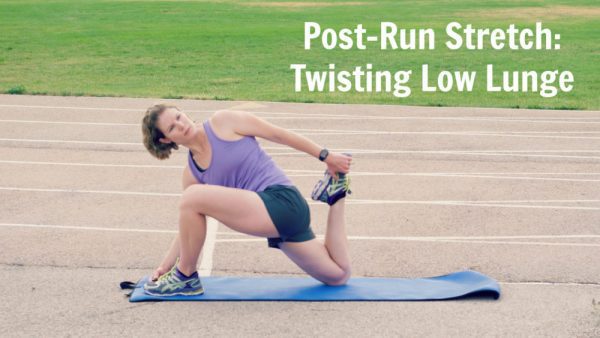
Poses to use caution with (use modifications as needed):
- 3 point balance (modified version of a standing split)
- Single leg (one legged) down dog
- Goddess
- Pyramid
- Pigeon (to comfort, listen to your hips in this one!)
- Right angle/side angle pose (I have to modify this one to keep my hips happy)
- Low lunge/also called high lunge in some circles
- Child’s pose (when my hips were inflamed, I modify this one by bringing my knees out wider)
- Cow face pose
- Humble warrior
- Eagle
- Revolved chair
- Half moon
- Warrior 3
- Triangle
- Seated butterfly (bound angle pose) – this one never bothers my hips because my knees are open, but it may be problematic for others
- Half lord of the fishes
- Frog pose (mandukasana specifically since there are several poses that go by frog pose)
- Lotus pose
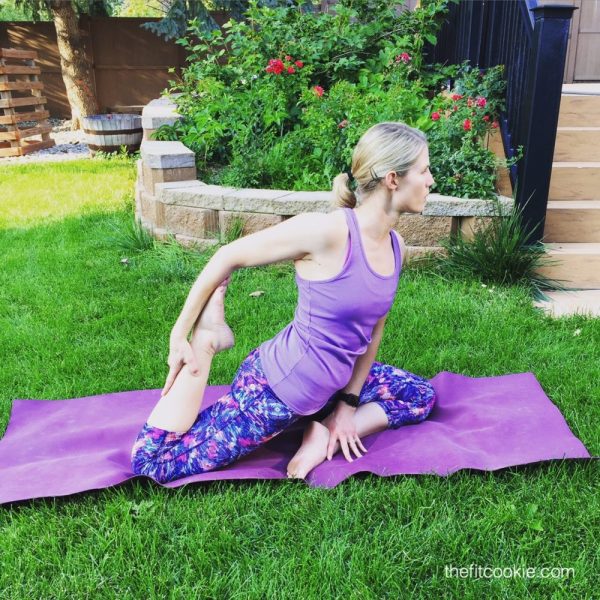
Poses that are generally okay:
- Warrior 2
- Warrior 1 (to comfort)
- High lunge/crescent lunge (to comfort)
- Puppy pose
- Down dog
- Reverse Warrior
- Forward fold/standing forward bend
- Half lift/standing half forward bend
- Seated forward bend
- Staff pose
- Bridge
- Plank
- Side plank
- Wild thing
- Standing half lotus
- Seated half lotus (can do this sitting upright for comfort)
- Gate pose
- Camel pose (shown higher in the post)
- …and more (there are many poses and pose variations out there, so this isn’t a comprehensive list)
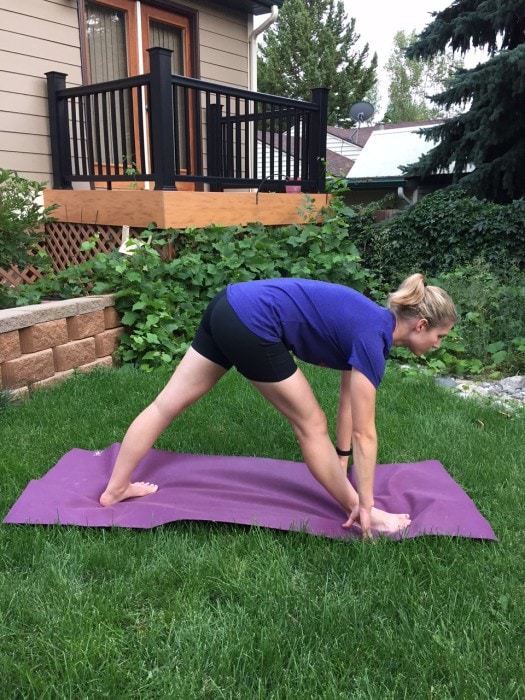
Pyramid Stretch, you can modify this one by using a block under your hands or placing your hands on your shin (just don’t hyperextend your knee)
Disclaimer: this post is for informational purposes only and is not intended to replace the advice of your medical professional, doctor, or physical therapist.
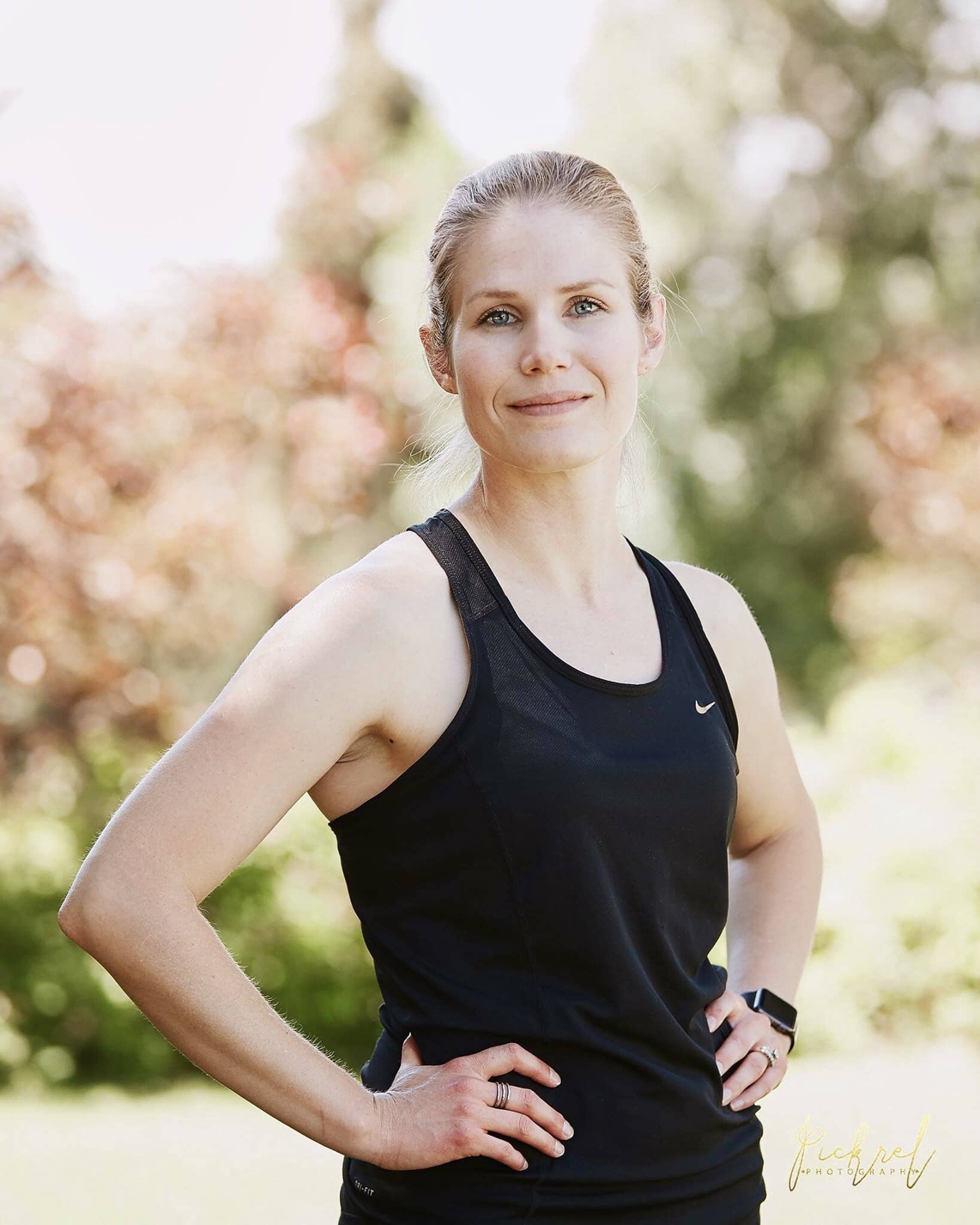
Sarah Jane Parker is the founder, recipe creator, and photographer behind The Fit Cookie. She’s a food allergy mom and healthy living blogger based in Wyoming. Sarah is also an ACSM Certified Personal Trainer, ACE Certified Health Coach, Revolution Running certified running coach, and an ACE Certified Fitness Nutrition Specialist

Thanks so much for this!
It took me a long time to start an everyday yoga practice and to my dismay, instead of feeling amazing, the front of my hips started hurting badly all day after my practice.
But I’m really thankful that you and another article I found have listed out the poses that are the culprits!
After two days of not practicing at all, my discomfort greatly improved and today I did my practice minus a few poses. Fingers-crossed that this will do the trick because I adore the daily practice. I just want to do good things for my mind and body so this will take intention, mindfulness and humble acceptance of which poses I can enjoy going forward.
Thanks again!
You’re welcome Justine!
Sarah – thank you for the article. I just googled “Yoga and FAI” because I haven’t done yoga since I tore my labrum in Dec. and I miss it! Thankfully running is ok for me. I’ll have to go read your surgery posts. If I am moving I don’t have pain, but with sitting, standing, and laying I have referred pain throughout my upper leg.
Glad you found us Meghan! If you have torn your labrum and it’s not just FAI, I’d definitely check with your doctor about doing yoga since that can put some stress on the labrum. I hope things go well for you!
Thank you Sarah for such a helpful article. It is great to know that your surgery went well. I hope you are recovering fine and have been able to get back to your fitness routine. Will be great to know how you are progressing. I have been diagnosed with Cam hip deformity and I am still waiting to meet the rehabilitation practitioner. I am waiting on him to understand what I can or cannot do as I have been living a very active life, I lift weights, do HIIT and cardio as well as yoga and I feel very compromised at the moment. So, thank you for the article, as it has been very helpful. Wishing you all the best.
Hi Charmaine! I’m doing pretty good these days, although I still have hip pain if I go into too deep of hip flexion on my left side (my surgery side). I’m not sure that will ever really go away. My left hip has always been more of a problem than my right hip, so far my right hip is doing well without surgery. But I’m still careful what I do, I haven’t been doing yoga lately (not because of my hips but I have just stopped doing it), and my weight lifting has been good but I do still avoid deep squats or deep deadlifts. I’m a little gun shy of some of those exercises now since I tore the labrum in my left hip doing deadlifts! I can still do them, I’m just more cautious with them and don’t go as low or heavy.
Hello 🙂
I have been diagnosed with FAI 2 months go and your blog really cheers me up, so thank you !
I don’t think I will have surgery yet, as the pain disappears in the following minutes after my sessions, I will probably just see a physiotherapist for now
But find it frustrating because I am unable to stretch for the splits (i feel a pinch in my hip in low lunge, as well as frog pose), and that was my main goal. Do you know anyone diagnosed with FAI who recovered through physiotherapy or surgery, and who got back a “normal” range of motion ? I am losing hope ^^’
Thank you very much !! And I hope the surgery will make your pain go away !
Thanks for stopping by Amy, I’m glad you found us! You’re definitely on the right track seeking help with a physical therapist or doctor. Depending on the level of impingement or type of impingement, you may not get the range of motion you’re looking for (i.e. for doing splits, etc.), but you’ll want to talk to your medical professional about that for sure. They’ll be able to give you a good idea of what to reasonably expect for the future for your hip range of motion.
I don’t know too many people personally who have had FAI, but the one acquaintance of mine who does have it ended up having surgery for torn labrum etc. So I don’t personally know many people who have it, or who have it and have good range of motion. You might need to take a break from deep poses for a while to help your hips.
This process for surgery has definitely felt like a long one. I hurt my hip in September and am looking at a surgery date of possibly beginning of March. My doctor even said that I will only have a little bit better range of motion in my left hip since he’s not aggressive with the surgery and only doing what’s necessary. So it will definitely be interesting for sure to see what happens with this! I’ll get a post or 2 written about the surgery and my recovery for sure.
Keep me posted with how you’re doing! I hope you get some answers and relief 🙂
Hi i have cam hip inpingment and have just started out yoga. Can i ask what made you decide to have the surgery was it casuing you pain all the time. Mine is more of annoyance than anything but i think is causing problems on my posterior chain due to imbalances on the hip. Is surgery the last resort
HI Chris! I did some deadlifts back in September that for some reason tore the labral cartilage in my left hip. I can live with the impingement (it’s frustrating but tolerable), but the labral tear has been painful, so we’re going to have surgery on it probably in a couple months. It was painful when I slept on my side, moved my leg a certain way, or did certain stretches, and the pain as becoming more constant.
The original doctor who I talked to at first was wanting to do a full labral reconstruction, but the doctor I’m seeing now is more conservative and wants to just do a labral repair and shave down the boney impingement on my left side, but doesn’t want to do anything for my right hip because it’s not bothering me (I have impingement on both sides, but a labral tear on only one side that I know of).
I definitely think that hip impingement can increase the chance of muscle imbalance, but your choice of doctor will determine what they think is the best approach for you. Some doctors are good with fixing impingement without labral tears, and others will not. And depending on what the doctor wants to do, it can be a long recovery.
My labral hip tear is limiting for me and painful, so I definitely need to get it fixed, but both doctors I talked to about my hip told me that not every labral tear will require surgery.
Ultimately, talk to your doctor and/or your physical therapist and see what options they think are best for you since it’s different for everyone. I plan on doing a blog post about my surgery and recovery once I have it done in the next couple months, so stay tuned for that 🙂
This is such a great article – thank you so much for posting. I’m a yoga teacher and have just been diagnosed with FAI.
Thank you Niya! I was hoping to do a video to go with this, but I’m going to have to wait for a while. I tore my labral hip cartilage in September doing deadlifts, so I am going to have surgery for it within the next month or 2. I won’t be able to post workout stuff for a while (except for surgery updates and stuff). I hope everything goes well with your hips! 🙂
Sarah,
I hope your surgery went well. I was just diagnosed with labral tear and they want to do injections. I’m modifying my class right now anyway because i’m teaching online due to Covid.
My injury is post operative after a liver transplant. I continued running and had an injury somewhere in there. Hoping to recover without invasive surgery.
My surgery went well, thank you! I wrote a blog post about my surgery and recovery, you can read it if you like: https://thefitcookie.com/labral-repair-hip-surgery/. Right now I’m 1 year out from surgery and doing pretty good. I hope your injections go well!
I would love a video. Thanks for addressing this!
Thanks Valerie! I plan on putting together a video soon, once I’m healed up from my surgery (probably next month) 🙂
I love this – I am definitely going to have to modify a lot until I am back to 100% post-op. Definitely sharing this – thanks so much for posting!
Thanks Annmarie! I’ll be adding video to this in the next couple weeks, so that will help too 🙂